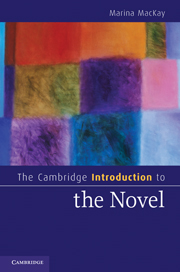Book contents
- Frontmatter
- Contents
- Acknowledgments
- About this book
- Chapter 1 Why the novel matters
- Miguel de Cervantes, Don Quixote (1605, 1615)
- Chapter 2 Origins of the novel
- Laurence Sterne, The Life and Opinions of Tristram Shandy, Gentleman (1759–67)
- Chapter 3 Narrating the novel
- James Hogg, The Private Memoirs and Confessions of a Justified Sinner (1824)
- Chapter 4 Character and the novel
- Nathaniel Hawthorne, The Scarlet Letter (1850)
- Chapter 5 Plotting the novel
- Gustave Flaubert, Madame Bovary (1857)
- Chapter 6 Setting the novel
- Charles Dickens, Bleak House (1853)
- Chapter 7 Time and history
- Virginia Woolf, To the Lighthouse (1927)
- Chapter 8 Genre and subgenre
- Graham Greene, The Ministry of Fear (1943)
- Chapter 9 Novel and anti-novel
- Thomas Pynchon, The Crying of Lot 49 (1966)
- Chapter 10 Novel, nation, community
- Salman Rushdie, Midnight's Children (1981)
- Chapter 11 Concluding
- Notes
- Glossary
- Further reading
- Index
- Cambridge Cultural Social Studies
Virginia Woolf, To the Lighthouse (1927)
Published online by Cambridge University Press: 05 June 2012
- Frontmatter
- Contents
- Acknowledgments
- About this book
- Chapter 1 Why the novel matters
- Miguel de Cervantes, Don Quixote (1605, 1615)
- Chapter 2 Origins of the novel
- Laurence Sterne, The Life and Opinions of Tristram Shandy, Gentleman (1759–67)
- Chapter 3 Narrating the novel
- James Hogg, The Private Memoirs and Confessions of a Justified Sinner (1824)
- Chapter 4 Character and the novel
- Nathaniel Hawthorne, The Scarlet Letter (1850)
- Chapter 5 Plotting the novel
- Gustave Flaubert, Madame Bovary (1857)
- Chapter 6 Setting the novel
- Charles Dickens, Bleak House (1853)
- Chapter 7 Time and history
- Virginia Woolf, To the Lighthouse (1927)
- Chapter 8 Genre and subgenre
- Graham Greene, The Ministry of Fear (1943)
- Chapter 9 Novel and anti-novel
- Thomas Pynchon, The Crying of Lot 49 (1966)
- Chapter 10 Novel, nation, community
- Salman Rushdie, Midnight's Children (1981)
- Chapter 11 Concluding
- Notes
- Glossary
- Further reading
- Index
- Cambridge Cultural Social Studies
Summary
Time the destroyer is time the preserver.
T. S. Eliot, “The Dry Salvages” (1941)Woolf's To the Lighthouse is a novel in three parts. The first, “The Window,” is set before the First World War in the house on the Hebridean island of Skye where the beautiful Mrs. Ramsay spends her summers along with her philosopher husband, her eight children, and invited guests. This is the longest of the novel's three sections and yet it covers the shortest period of “real” time, only a single afternoon and the long evening of a summer's day. In contrast, the novel's middle section “Time Passes,” which describes what happens to the house after the Ramsays stop coming, spans ten years in a small fraction of the pages occupied by the novel's opening section. Also much longer than this middle section is the novel's conclusion, “The Lighthouse,” which covers only a morning spent at the house by the survivors of the old family; here the painter Lily Briscoe, a longstanding summer guest of the Ramsays, assumes the central role that the now-dead Mrs. Ramsay played in “The Window.” In total, then, the time spanned by the novel is more than ten years, but the bulk of the narrative is given over to the less than two days that occupy the novel's first and third sections.
- Type
- Chapter
- Information
- The Cambridge Introduction to the Novel , pp. 131 - 134Publisher: Cambridge University PressPrint publication year: 2010

